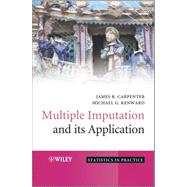
James Carpenter, Medical Statistics Unit, London School of Hygiene and Tropical Medicine, UK.
Michael G. Kenward, Medical Statistics Unit, London School of Hygiene and Tropical Medicine, UK
Amongst other areas Professor Kenward has worked in pre-clinical and clinical medicine and epidemiology for over twenty years, holding a number of international positions. He has also been a statistical consultant for over twenty years, predominantly in medical research. He has taught over 80 short courses in biostatistics throughout the world, and is the author of the book Analysis of Repeated Measurements.
Both authors act as consultants in missing data problems in biostatistics for several major pharmaceutical companies. They have been funded since 2002 by the UK Economic and Social Research Council to develop multiple imputation software for multilevel data, and to provide training for research scientists in the handling of missing data from observational studies.
I Foundations
1 Introduction
1.1 Reasons for missing data
1.1.1 Patterns of missing data
1.1.2 Consequences of missing data
1.2 Inferential framework and notation
1.2.1 Missing Completely At Random (MCAR)
1.2.2 Missing At Random (MAR)
1.2.3 Missing Not At Random (MNAR)
1.2.4 Ignorability
1.3 Using observed data to inform assumptions about the missingness mechanism
1.4 Implications of missing data mechanisms for regression analyses
1.4.1 Partially observed response
1.4.2 Missing covariates
1.4.3 Missing covariates and response
1.4.4 Subtle issues I: the odds ratio
1.4.5 Implication for linear regression
1.4.6 Subtle issues II: sub sample ignorability
1.4.7 Summary: when restricting to complete records is valid
1.5 Summary
2 The Multiple Imputation Procedure and Its Justification
2.1 Introduction
2.2 Intuitive outline of the MI procedure
2.3 The generic MI Procedure
2.4 Bayesian justification of MI
2.5 Frequentist Inference
2.6 Choosing the number of imputations
2.7 Some simple examples
2.8 MI in More General Settings
2.8.1 Survey Sample Settings
2.9 Practical considerations for choosing imputation models
2.10 Discussion
II Multiple imputation for cross sectional data
3 Multiple imputation of quantitative data
3.1 Regression imputation with a monotone missingness pattern
3.1.1 MAR mechanisms consistent with a monotone pattern
3.1.2 Justification
3.2 Joint modelling
3.2.1 Fitting the imputation model
3.3 Full conditional specification
3.3.1 Justification
3.4 Full conditional specification versus joint modelling
3.5 Software for multivariate normal imputation
3.6 Discussion
4 Multiple imputation of binary and ordinal data
4.1 Sequential imputation with monotone missingness pattern
4.2 Joint modelling with the multivariate normal distribution
4.3 Modelling binary data using latent normal variables
4.3.1 Latent normal model for ordinal data
4.4 General location model
4.5 Full conditional specification
4.5.1 Justification
4.6 Issues with over-fitting
4.7 Pros and cons of the various approaches
4.8 Software
4.9 Discussion
5 Imputation of unordered categorical data
5.1 Monotone missing data
5.2 Multivariate normal imputation for categorical data
5.3 Maximum indicant model
5.3.1 Continuous and categorical variable
5.3.2 Imputing missing data
5.3.3 More than one categorical variable
5.4 General location model
5.5 FCS with categorical data
5.6 Perfect prediction issues with categorical data
5.7 Software
5.8 Discussion
6 Non-linear relationships
6.1 Passive imputation
6.2 No missing data in non-linear relationships
6.3 Missing data in non-linear relationships
6.3.1 Predictive Mean Matching (PMM)
6.3.2 Just Another Variable (JAV)
6.3.3 Joint modelling approach
6.3.4 Extension to more general models and missing data pattern
6.3.5 Metropolis Hastings sampling
6.3.6 Rejection sampling
6.3.7 FCS approach
6.4 Discussion
7 Interactions
7.1 Interaction variables fully observed
7.2 Interactions of categorical variables
7.3 General non-linear relationships
7.4 Software
7.5 Discussion
III Advanced Topics
8 Survival data, skips and large datasets
8.1 Time to event data
8.1.1 Imputing missing covariate values
8.1.2 Survival data as categorical
8.1.3 Imputing censored survival times
8.2 Non-parametric, or `hot deck' imputation
8.2.1 Non-parametric imputation for survival data
8.3 Multiple imputation for skips
8.4 Two-stage MI
8.5 Large datasets
8.5.1 Large datasets and joint modelling
8.5.2 Shrinkage by constraining parameters
8.5.3 Comparison of the two approaches
8.6 Multiple Imputation and record linkage
8.7 Measurement error
8.8 Multiple imputation for aggregated scores
8.9 Discussion
9 Multilevel multiple imputation
9.1 Multilevel imputation model
9.2 MCMC algorithm for imputation model
9.3 Imputing level 2 covariates using FCS
9.4 Individual patient meta-analysis
9.4.1 When to apply Rubin's rules
9.5 Extensions
9.5.1 Random level-1 covariance matrices
9.5.2 Model_t
9.6 Discussion
10 Sensitivity analysis: MI unleashed
10.1 Review of MNAR modelling
10.2 Framing sensitivity analysis
10.3 Pattern mixture modelling with MI
10.3.1 Missing covariates
10.3.2 Application to survival analysis
10.4 Pattern mixture approach with longitudinal
data via MI
10.4.1 Change in slope post-deviation
10.5 Piecing together post-deviation distributions from other trial arms
10.6 Approximating a selection model by importance weighting
10.6.1 Algorithm for approximate sensitivity analysis by reweighting
10.7 Discussion
11 Including survey weights
11.1 Using model based predictions
11.2 Bias in the MI Variance Estimator
11.2.1 MI with weights
11.2.2 Estimation in Domains
11.3 A multilevel approach
11.4 Further developments
11.5 Discussion
12 Robust Multiple Imputation
12.1 Introduction
12.2 Theoretical background
12.2.1 Simple Estimating equations
12.2.2 The probability of missingness (POM) model
12.2.3 Augmented inverse probability weighted
estimating equation
12.3 Robust Multiple Imputation
12.3.1 Univariate MAR missing data
12.3.2 Longitudinal MAR missing data
12.4 Simulation studies
12.4.1 Univariate MAR missing data
12.4.2 Longitudinal monotone MAR missing data
12.4.3 Longitudinal non-monotone MAR missing data
12.4.4 Non-longitudinal non-monotone MAR missing data
12.4.5 Conclusions
12.5 The RECORD study
12.6 Discussion
Appendix A Markov Chain Monte Carlo
Appendix B Probability distributions
B.1 Posterior for the multivariate normal distribution
Bibliography
Index
The New copy of this book will include any supplemental materials advertised. Please check the title of the book to determine if it should include any access cards, study guides, lab manuals, CDs, etc.
The Used, Rental and eBook copies of this book are not guaranteed to include any supplemental materials. Typically, only the book itself is included. This is true even if the title states it includes any access cards, study guides, lab manuals, CDs, etc.